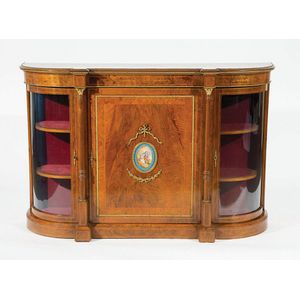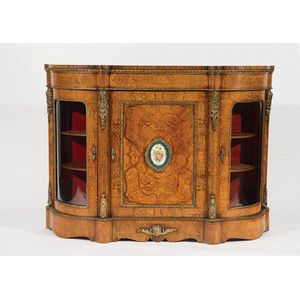Victorian Walnut Marquetry Side Cabinet with Sevres Plaque
You must be a subscriber, and be logged in to view price and dealer details.
Subscribe Now to view actual auction price for this item
When you subscribe, you have the option of setting the currency in which to display prices to $Au, $US, $NZ or Stg.
- Ormolu - Ormolu was popular with French craftsmen in the 18th and 19th century for ornamental fittings for furniture, clocks and other decorative items. True ormolu is gilt bronze, that is bronze that has been coated with gold using a mercury amalgam. Due to the health risks associated with using mercury, this method of creating ormolu was discontinued in France in the 1830s. A substitute was developed consisting of about 75% copper and 25% zinc, however it was inferior to the bronze version. It was often lacquered to prevent it tarnishing.
- Mounts - Mounts are used to describe bronze, brass and ormolu adornments on furniture especially quality furniture in the rococo and classical revival style, and are also the cabinet makers' name for the metal fittings on furniture, such as hinges, locks and handles, and metal edges and guards which protect furniture from damage.
- Victorian Period - The Victorian period of furniture and decorative arts design covers the reign of Queen Victoria from 1837 to 1901. There was not one dominant style of furniture in the Victorian period. Designers used and modified many historical styles such as Gothic, Tudor, Elizabethan, English Rococo, Neoclassical and others, although use of some styles, such as English Rococo and Gothic tended to dominate the furniture manufacture of the period.
The Victorian period was preceded by the Regency and William IV periods, and followed by the Edwardian period, named for Edward VII (1841 ? 1910) who was King of the United Kingdom and the British Dominions and Emperor of India for the brief period from 1901 until his death in 1910. - Marquetry - In marquetry inlay, contrasting woods, and other materials such as ivory, shell and metal are inlaid either as panels or in a single continuous sheet over the surface of the piece. The design may be straightforward, such as a shell pattern or a basket of flowers, or it may be infinitely complex, with swirling tendrils of leaves, flowers and foliage, such as one finds, for example, in the "seaweed" patterns on longcase clocks of the William and Mary and Queen Anne periods.
This item has been included into following indexes:
-
cabinets, material
- ormolu and bronze mounted 232
- painted 158
- walnut 675
- side cabinets 231
Visually similar items

A fine Victorian English gilt mounted walnut credenza, later 19th century, the credenza having a central cupboard flanked by curved, glazed and velvet lined display cupboards, a striking book end veneer panelled top and intricate knot and strap work throug

Victorian walnut inverted breakfront credenza central panel door with painted Sevres style oval plaque, flanked by shelving enclosed by bowed glass doors, fluted tapering column supports on box base, the whole with gilt metal mounts

Antique English oak apprentice two door wardrobe, 55 cm high, 46 cm wide, 18 cm deep

A Victorian carved oak book-case cabinet, latter half 19th century, the upper part with a scrolling pediment and moulded cornice above a pair of glazed doors enclosing adjustable shelves, the projecting lower part with a pair of frieze drawers above a pair
